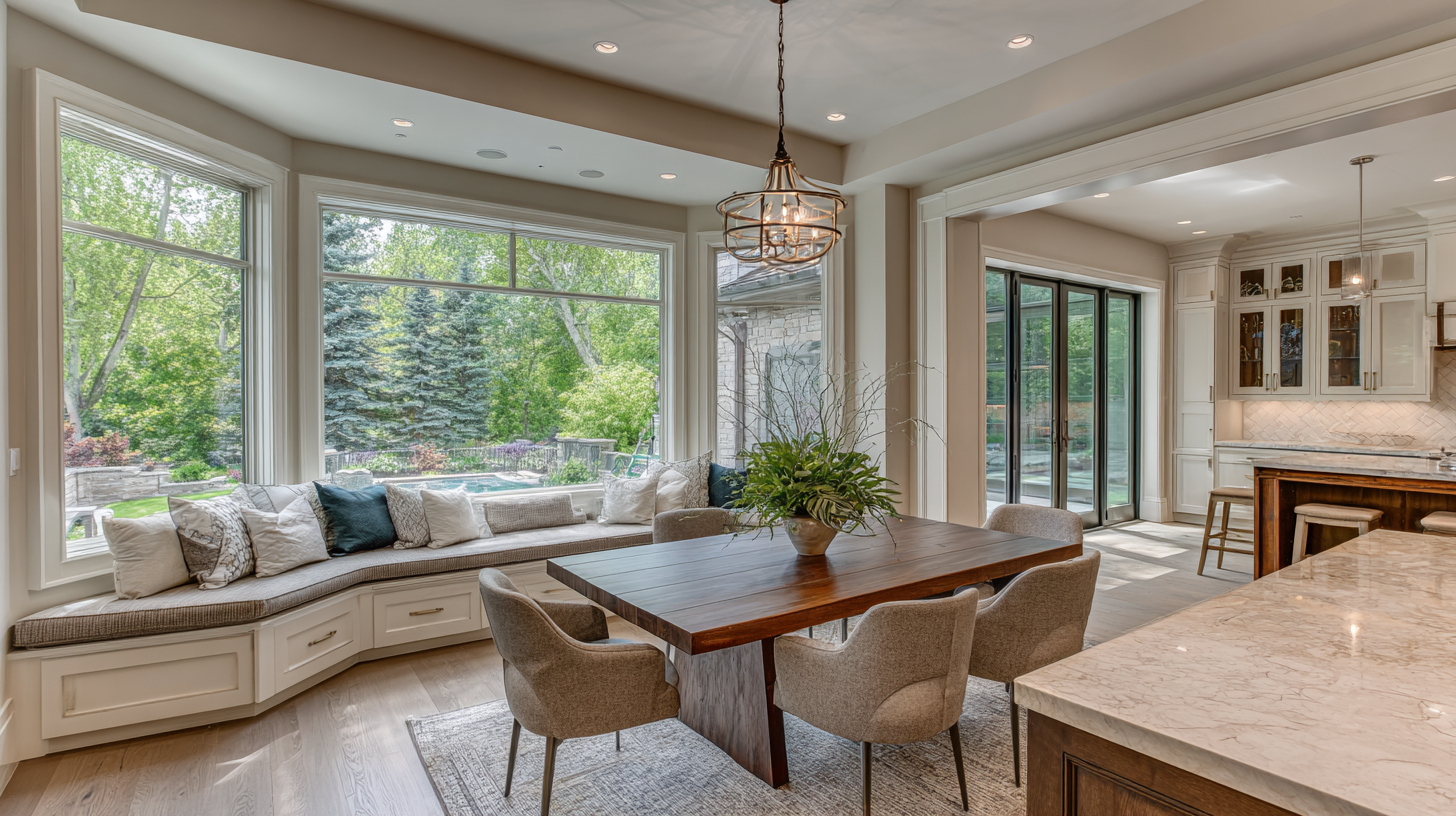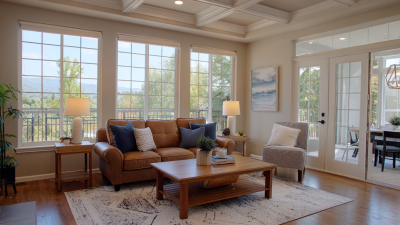Unlocking Energy Savings: Why Efficient Windows Are Essential for Modern Homeowners
In today's rapidly changing climate and rising energy costs, homeowners are increasingly seeking ways to enhance their property’s energy efficiency. One of the most significant advancements in home energy performance is the adoption of efficient windows. According to the U.S. Department of Energy, windows account for nearly 25-30% of a home’s heating and cooling energy use, emphasizing the critical role of window efficiency in overall energy consumption. Moreover, studies from the National Renewable Energy Laboratory indicate that upgrading to efficient windows can reduce energy bills by up to 15%, a compelling motivation for modern homeowners. As energy efficiency becomes a priority, understanding the importance of efficient windows not only aids in cutting costs but also contributes to a more sustainable living environment, ultimately paving the way for smarter, eco-conscious home design.

Table of Contents
[Hide]
Understanding Energy Efficiency in Windows
Choosing the right windows is crucial for modern homeowners seeking energy efficiency. Efficient windows not only enhance the aesthetic appeal of your home but also significantly reduce energy consumption and utility bills. Understanding energy efficiency in windows involves looking at various factors, including the materials used, the type of glazing, and installation techniques. For example, double or triple-glazed windows filled with inert gases provide superior insulation compared to single-pane options.
Tip: Always check the energy rating label when purchasing windows. This label indicates how well the window reduces heat transfer, helping you select the most efficient options available.
Additionally, selecting windows that offer low-emissivity (Low-E) coatings can further improve energy efficiency. These coatings reflect heat during summer and retain warmth during winter, making your home comfortable year-round. Proper installation is also vital; even the most energy-efficient window will perform poorly if installed incorrectly.
Tip: Consider hiring a professional for installation to ensure that your windows are sealed and fitted properly, maximizing their energy-saving potential.
The Impact of Window Quality on Home Energy Consumption
When it comes to energy consumption in homes, the quality of windows plays a pivotal role.
Inefficient windows can lead to considerable heat loss in the winter and heat gain in the summer, forcing homeowners to spend more on heating and cooling. This not only increases energy bills but also places a significant strain on environmental resources.
Investing in high-quality windows can mitigate these issues, leading to a more comfortable living environment and substantial savings over time.
Tips for choosing energy-efficient windows include looking for double or triple glazing, which provides better insulation than single-pane windows. Homeowners should also consider the solar heat gain coefficient (SHGC) and U-factor ratings, as these measures indicate how well a window can resist heat transfer.
Additionally, proper installation is crucial; even the best windows can perform poorly if not fitted correctly. Regular maintenance, such as checking for drafts and ensuring seals are intact, can also prolong the lifespan and efficiency of windows.
By prioritizing window quality, modern homeowners can significantly lower their energy consumption. Making informed choices about window materials, like
low-emissivity (Low-E) coatings, can enhance energy efficiency, reflecting heat during the summer while retaining warmth in the winter. These upgrades not only contribute to a sustainable future but also increase the overall value of the home.
Comparing Different Types of Energy-Efficient Windows
When considering energy-efficient windows, homeowners are often faced with a multitude of options, each with unique properties and benefits. Among the most popular types are double-glazed, triple-glazed, and low-emissivity (Low-E) windows. According to the U.S. Department of Energy, replacing single-pane windows with double-glazed options can lead to energy savings of up to 24% on heating bills and 18% on cooling costs. This is due to the insulating properties of the air or gas trapped between the panes, which significantly reduces heat transfer.

Triple-glazed windows take efficiency a step further, offering superior insulation by using three layers of glass. The National Association of Home Builders (NAHB) highlights that triple glazing can improve energy efficiency by an additional 10-20% compared to double-glazed windows. Low-E coatings are another critical feature to consider; these coatings reflect infrared light while allowing visible light to pass through, thereby enhancing thermal performance without sacrificing natural sunlight. Recent studies indicate that windows with Low-E coatings can reduce energy loss by up to 50%, making them a cornerstone of energy-efficient home design.
Each type of energy-efficient window serves a role in sustainable building, allowing homeowners not only to save on energy bills but also to contribute to a reduced carbon footprint. Understanding these options is essential for making informed choices that align with both financial and environmental goals.
The Long-Term Financial Benefits of Upgrading Windows
Upgrading your windows can bring significant long-term financial benefits that modern homeowners should not overlook. Energy-efficient windows play a crucial role in reducing heating and cooling costs, as they help maintain a stable indoor temperature. By minimizing heat loss in winter and reducing heat gain in summer, homeowners can save substantially on their energy bills. Furthermore, the initial investment in quality windows often pays off through lower utility expenses and increased property value over time.
**Tip:** When looking for energy-efficient windows, consider models with double or triple glazing, low-emissivity (Low-E) coatings, and insulated frames to maximize thermal performance.
In addition to the direct financial savings, efficient windows enhance overall comfort and promote a healthier living environment by reducing drafts and noise pollution. With advancements in window technology, numerous options cater to various aesthetic preferences while maintaining efficiency. Homeowners not only invest in their immediate comfort but also in the sustainability of their homes.
**Tip:** Research available tax credits or rebates for energy-efficient home improvements, which can further offset the cost of window upgrades and encourage sustainable practices.

Key Features to Look for in Modern Energy-Efficient Windows
When selecting modern energy-efficient windows, homeowners should focus on several key features that significantly impact performance. First, the window frame material plays a crucial role in insulation. Options like vinyl, fiberglass, and wood-clad frames provide varied levels of thermal resistance, which affects the overall energy efficiency of the window. Additionally, multi-chambered frames and insulated spacers contribute to minimizing heat transfer, making them ideal choices for reducing energy costs.
Another critical feature to consider is the glazing type. Double or triple-pane glass, filled with inert gases such as argon or krypton, significantly enhances thermal insulation compared to single-pane windows. Low-emissivity (Low-E) coatings on the glass surface reflect heat back into the home during the winter and keep it out during the summer, optimizing indoor comfort year-round. By prioritizing these elements, homeowners can ensure that their investment in energy-efficient windows leads to substantial long-term savings and a more sustainable living environment.
Unlocking Energy Savings: Why Efficient Windows Are Essential for Modern Homeowners
| Feature | Description | Benefits | Energy Savings Potential |
|---|---|---|---|
| Low-E Glass | Glass with a special coating that reflects heat and UV rays. | Reduces energy costs by keeping homes cooler in summer and warmer in winter. | Up to 30% savings on heating and cooling bills. |
| Double or Triple Glazing | Windows made with two or three layers of glass. | Enhanced insulation prevents heat transfer. | Can improve insulation values by 50% or more. |
| Gas Fills | Inert gases like argon or krypton between the glass panes. | Further reduces heat transfer and improves energy efficiency. | Enhances energy performance ratings significantly. |
| Frame Material | Materials like vinyl, fiberglass, or wood. | Improves durability and thermal performance. | Reduces overall heating and cooling costs by maintaining temperature. |
| Solar Heat Gain Coefficient (SHGC) | A measure of how much solar heat is allowed through windows. | Helps to maximize natural light while minimizing heat gain. | Can save up to 30% on air conditioning in warm climates. |
Related Posts
-

What are the Benefits of Choosing Energy Efficient Windows for Your Home
-

Unlocking Energy Savings with Efficient Windows for Sustainable Living
-

Exploring Unique Alternatives to Traditional Big Windows for Modern Spaces
-

Ultimate Guide to Selecting the Best Insulated Windows for Your Global Sourcing Needs
-

How to Enhance Your Home Aesthetic with French Windows
-

Exploring the Future of Style Windows at the 138th Canton Fair 2025: Trends and Insights